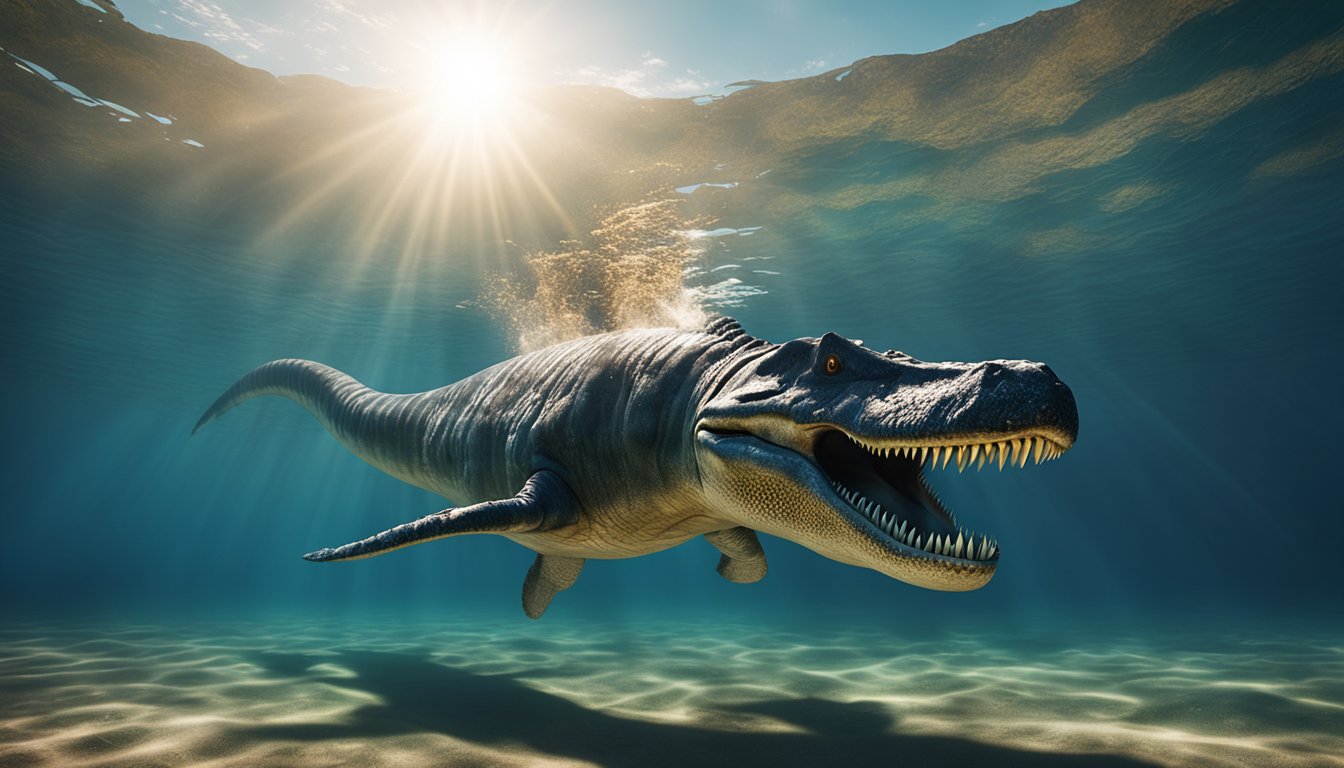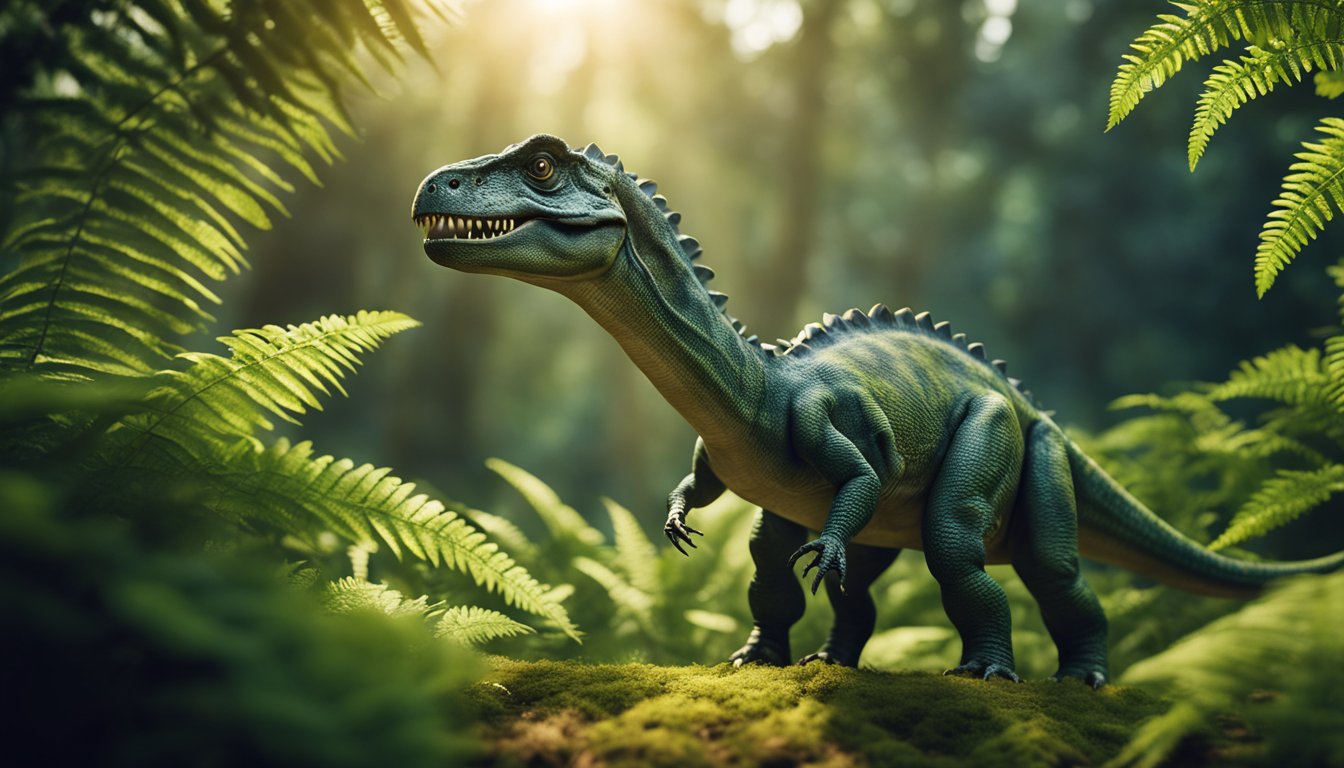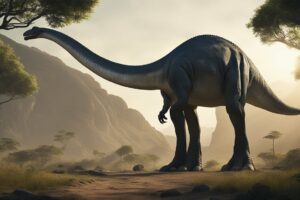Mosasaurus was a massive marine lizard that roamed the ancient oceans during the Cretaceous period, between 100 and 66 million years ago.
These creatures were part of a group of marine reptiles known as mosasaurs, which were some of the largest and most fearsome predators of their time.
Mosasaurus was one of the largest of these creatures, with some species growing up to 60 feet long.

Despite their fearsome reputation, mosasaurs were actually quite graceful swimmers.
Their long, streamlined bodies and powerful tails allowed them to move through the water with ease, while their paddle-like limbs helped them to steer and maneuver.
Mosasaurus was also equipped with a set of sharp teeth, which it used to catch and eat its prey.
These teeth were constantly being replaced throughout the creature’s life, ensuring that it always had a fresh set of sharp weapons at its disposal.
Today, mosasaurs are extinct, but their fossils can still be found all over the world.
These fossils provide scientists with valuable insights into the lives of these ancient creatures, and help us to better understand the history of life on Earth.
So if you ever come across a mosasaur fossil, take a moment to marvel at the incredible creature that once roamed the seas, and the mysteries that it still holds.
Unveiling the Mosasaurus
Defining Characteristics
Mosasaurus, a genus of mosasaurs, was a massive marine lizard that lived during the Late Cretaceous period, approximately 70-66 million years ago.
Mosasaurs were the last of the great marine reptiles and were known for their impressive size, elongated bodies, and powerful jaws.
Mosasaurus, in particular, was one of the largest species of mosasaurs, measuring up to 18 meters in length.
The defining characteristic of Mosasaurus is its elongated, streamlined body, which allowed it to swim with ease through the water.
Its powerful tail provided the necessary propulsion, while its long, slender limbs enabled it to steer and maneuver in the water.
The jaws of Mosasaurus were equipped with numerous sharp teeth that were used to catch and eat its prey.
Evolutionary History
Mosasaurus evolved from smaller, more primitive mosasaurs, which first appeared in the fossil record during the Late Cretaceous period.
Over time, mosasaurs became larger and more specialized, adapting to life in the ocean and becoming apex predators in their ecosystem.
The first fossils of Mosasaurus were discovered in the Netherlands in 1764, and since then, numerous other fossils have been found around the world, including in North America, Africa, and Europe.
The discovery of these fossils has provided scientists with valuable insights into the evolutionary history of mosasaurs and their place in the larger context of dinosaur and marine reptile evolution.
Today, Mosasaurus hoffmanni is the most well-known species of Mosasaurus, and it has become a popular subject of study among palaeontologists and taxonomists.
Through the study of fossils and the analysis of DNA, scientists continue to learn more about the biology and behaviour of Mosasaurus and other mosasaurs, shedding new light on the fascinating history of these ancient marine lizards.
Fun Fact: Did you know that Mosasaurus was not a dinosaur, but rather a marine lizard that lived during the same time period as dinosaurs?
Lifestyle of an Ancient Predator

Mosasaurus was a massive marine lizard that ruled the ancient oceans.
It was a member of the Mosasauridae family, which were ambush predators that sat at the top of the food chain.
Here we will explore the hunting techniques, diet, and prey of this fascinating creature.
Hunting Techniques
Mosasaurus was a swimming predator that used its shark-like tail to move through the water with incredible speed.
It was an apex predator, which means that it had no natural predators in the ocean.
Mosasaurus was known for its ability to ambush its prey, using its powerful jaws to deliver a fatal bite.
It had a flexible skull that allowed it to swallow its prey whole, which it would then digest in its gut.
Diet and Prey
Mosasaurus was a carnivore with a diverse diet. It hunted a variety of marine animals, including fish, turtles, and other mosasaurs.
Some researchers have even suggested that it may have preyed on small dinosaurs that ventured into the water.
Mosasaurus had many adaptations that made it an effective predator, including sharp teeth, a powerful bite, and a streamlined body that allowed it to move quickly through the water.
Fun fact: Mosasaurus was not the only giant marine predator of its time.
It shared the ocean with other creatures like the giant shark Cretoxyrhina and the plesiosaur Elasmosaurus.
In conclusion, Mosasaurus was an incredible creature that lived in the ancient oceans.
Its hunting techniques, diet, and prey made it one of the most fearsome predators of its time.
Today, scientists continue to study these fascinating creatures to learn more about the history of life on Earth.
Mosasaurus in the Ecosystem

Coexistence with Other Marine Giants
Mosasaurus was not the only massive marine reptile that roamed the ancient oceans.
Other marine giants such as the plesiosaur and ichthyosaurs were also present during the same time period.
These creatures had different body structures and feeding habits, which allowed them to coexist without competition.
The plesiosaur, for example, had a long neck and small head, which allowed it to catch small fish and squid.
The ichthyosaurs, on the other hand, had a streamlined body and powerful tail, which allowed it to swim fast and catch fast-moving prey.
Mosasaurus, with its massive jaws and sharp teeth, was the apex predator of the ancient oceans and fed on a variety of prey, including fish, squid, and even other marine reptiles.
Role in the Food Chain
As an apex predator, Mosasaurus played a crucial role in the ecosystem of the ancient oceans.
Its presence helped to control the population of other marine creatures, preventing overpopulation and ensuring that the ecosystem remained balanced.
Mosasaurus also helped to maintain the diversity of the marine environment by preying on different types of creatures.
Its massive size and predatory nature made it an important part of the food chain, and its extinction had a significant impact on the ecosystem of the ancient oceans.
One fascinating fact about Mosasaurus is that it was able to breathe air like modern-day whales and dolphins.
This allowed it to spend long periods of time underwater, hunting for prey, before returning to the surface to breathe.
Another interesting fact is that Mosasaurus was not a dinosaur, but a type of marine reptile that lived during the Late Cretaceous period.
Despite its fearsome appearance, Mosasaurus was not closely related to modern-day reptiles such as snakes and lizards.
Instead, it belonged to a group of reptiles called the squamates, which also includes modern-day snakes and lizards.
Overall, Mosasaurus was a fascinating creature that played an important role in the ecosystem of the ancient oceans.
Its massive size and predatory nature made it an apex predator, and its presence helped to maintain the balance and diversity of the marine environment.
The End of an Era

The Cretaceous-Tertiary Extinction Event
The Cretaceous period marked the end of the age of the dinosaurs.
It was a time of great change and upheaval, with volcanic activity, fluctuating sea levels, and the emergence of new species.
However, the most significant event of the Cretaceous period was the asteroid impact that occurred around 66 million years ago.
The impact caused widespread devastation, leading to the extinction of the dinosaurs and many other species.
The asteroid impact led to a mass extinction event known as the Cretaceous-Tertiary extinction event.
The extinction event had a profound impact on the Earth’s biodiversity, with an estimated 75% of all species going extinct.
The event also marked the end of the Mesozoic era and the beginning of the Cenozoic era.
Fossil Discoveries and Research
The discovery of fossils of Mosasaurus has been instrumental in advancing our understanding of the Cretaceous period and the events that led to the extinction of the dinosaurs.
Mosasaurus was a massive marine lizard that ruled the oceans during the late Cretaceous period.
Scientists at the Richard Gilder Graduate School and the American Museum of Natural History have been studying Mosasaurus fossils to gain insight into its behavior, physiology, and evolution.
The fossils have revealed that Mosasaurus was a formidable predator, with sharp teeth and powerful jaws.
It was also an excellent swimmer, capable of reaching speeds of up to 30 miles per hour.
Museum exhibits featuring Mosasaurus fossils have been popular with visitors, especially children.
The fossils provide a tangible link to the past, allowing visitors to imagine what life was like during the Cretaceous period.
The popularity of Mosasaurus exhibits has inspired many young people to pursue careers in science and paleontology.
Fun fact: Did you know that Mosasaurus was not actually a dinosaur? It was a marine reptile that belonged to a group of lizards known as mosasaurs.
Frequently Asked Questions

How large could a Mosasaurus grow in terms of length and weight?
Mosasaurus was a massive marine reptile that could grow up to 50 feet long and weigh up to 15 tons.
That’s longer than a school bus and heavier than a dump truck!
Its body was streamlined and powerful, with four flippers and a long, muscular tail that helped it swim through the water with ease.
What type of diet sustained the massive Mosasaurus during its reign in the oceans?
Mosasaurus was a fierce predator that ate a variety of prey, including fish, squid, and other marine reptiles.
Its sharp teeth were perfect for tearing through tough flesh, and its powerful jaws could crush even the hardest shells.
Mosasaurus was at the top of the food chain in the late Cretaceous period, and its size and strength made it an apex predator.
Can you compare the Mosasaurus and the Megalodon in terms of size and predatory behavior?
Although both Mosasaurus and Megalodon were massive predators that ruled the oceans, they were very different in terms of size and predatory behavior.
Mosasaurus was a reptile that lived in the water, while Megalodon was a shark.
Mosasaurus was longer than Megalodon, but Megalodon was heavier and had more powerful jaws.
Both animals were apex predators and hunted a variety of prey, but Megalodon was more of a scavenger than Mosasaurus.
Where have scientists found Mosasaurus fossils, and what have these discoveries taught us?
Mosasaurus fossils have been found all over the world, from North America to Europe to Asia.
These discoveries have taught us a great deal about the biology and behavior of these ancient marine reptiles.
For example, we now know that Mosasaurus was a powerful swimmer with a streamlined body and muscular tail, and that it was a fierce predator that hunted a variety of prey.
What are some of the theories about how the Mosasaurus species became extinct?
There are several theories about how the Mosasaurus species became extinct.
One theory is that a massive asteroid impact caused a global extinction event that wiped out many species, including Mosasaurus.
Another theory is that changes in the climate and sea level caused the oceans to become less hospitable for Mosasaurus, leading to their decline and eventual extinction.
Are there any living descendants of the Mosasaurus, or which modern animals are considered its relatives?
There are no living descendants of Mosasaurus, as the species went extinct millions of years ago.
However, there are several modern animals that are considered its relatives, including snakes and lizards.
Mosasaurus was a member of the family Mosasauridae, which is now extinct, but its legacy lives on in the many reptiles that still inhabit our planet today.






